Technical writing and UX writing are valuable complementary areas for improving products, user engagement, and experiences.
While technical writing focuses on communicating complex and technical information precisely and in detail, UX writing specializes in creating texts that improve the user experience with digital products, such as mobile apps and websites.
The primary purpose of technical writing is to provide customers with specific, step-by-step instructions for using products or solving technical problems. However, The fundamental goal of UX writing is to make the user’s interaction with the product as intuitive and pleasant as possible.
These two disciplines have emerged in digital communication to ensure clarity, efficiency, and usability. Although both aim to improve the user experience, they focus on different aspects of communication. In this article, we will explore the differences between technical writing and UX writing, highlighting their characteristics, objectives, and application examples.
Technical Writing Vs UX Writing: Distinct But Complementary Areas
Although both areas aim to speak instructions correctly, they vary in phrases of target market, context, and recognition. While technical writing focuses on conveying notable and correct facts to customers with particular understanding, UX writing aims to simplify and decorate the Customer Journey for various users, regardless of their technical ability degree. Professionals in these areas regularly collaborate to ensure clear conversations and compelling language that meets customers’ needs.
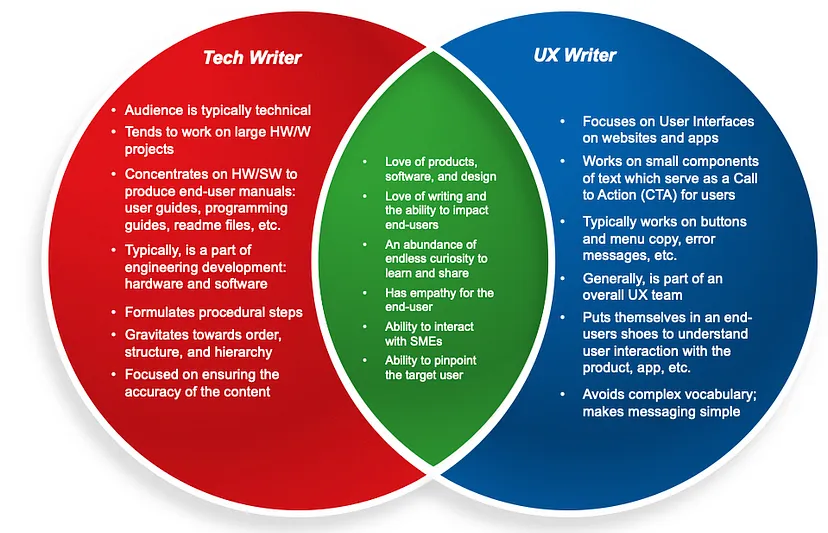
© Medium
What Is Technical Writing
Technical writing refers to textual genres meant for business and institutional conversation. The technical text group comprises circulars, receipts, business letters, minutes, memoranda, and other textual genres. Technical Writing is a form of writing that focuses on creating clear, precise documents to convey complex information in an understandable way.
The genres that might be a part of this institution have common traits, such as the usage of concise and objective language and independent writing through the same old norms of the language. As for the structural factor, its construction depends on the sort of textual content in the query. The memorandum has its own shape, as does the user manual, for example.
What Are the Characteristics of Technical Writing?
Technical writing characterizes the distinct textual genres utilized in institutions, whose goal is to set up a proper conversation between the divisions or segments that cause them to rise. To acquire this, technical writing is primarily based on the subsequent traits:
- Discursive purpose aimed at information and clarification;
- Use of denotative language (words expressed with their original meaning in mind);
- Predominance of the referential function (focus maintained strictly on the referent, that is, on the subject addressed in the message);
- Impartiality and accuracy, prioritizing the effectiveness of language.
- Use of the standard norm of the language.
These characteristics are justified by the context used in technical writing. Interpretive errors or jargon aren’t suited to commercial enterprise surroundings or public workplaces. A technical writer’s communication goals are to be clear and goal-oriented so as not to create obstacles to ongoing processes.
Technical Writers
Tech writers are essential in creating technical files, including consumer manuals, know-how-based articles, and product documentation. They focus on technical writing and communicate complicated facts in a clear and concise manner to numerous audiences, including technology writers and user-experience designers.
A tech writer often collaborates with professionals, including copywriters and designers, to ensure that the documentation created meets the end consumer’s needs. They can also conduct personal research to understand clients’ wishes and alternatives better. They create documentation that offers comprehensible technical overviews to the target audience.
In addition to creating documentation, technical writers can also play the role of writing educators, sharing their talents and understanding with other crew members. In short, technical writers are critical in developing accurate and accessible technical documentation, contributing to consumer experience and product achievement.
Examples of Technical Writing
Here are the examples of technical writing:
Press Releases
Press releases are documents that deliver essential updates or announcements in a concise and engaging manner, typically spanning one or more pages.
Technical writers must design the text to attract media interest and ensure journalistic coverage. They can announce business statistics, such as the launch of new products, provide information about upcoming public events, inform about adjustments in company leadership, or announce financing and investments.
Press releases can also be vital tools for publicizing awards received, managing crises, expressing hierarchical adjustments, and selling the enterprise’s social actions.
The effectiveness of a press release depends on its readability, objectivity, and ability to capture the interest of reporters and the public.
A brief and effective example is the McDonald’s press release, which stands out for its clarity, objectivity, and alignment with the company’s purpose of announcing an important social action.

© Scribd
API Documentation
API documentation is a resource that includes references, tutorials, and examples to help developers use an API effectively. In summary, it explains what the API can do and how to get started, as well as answers questions about syntax and functionality.
Typically, this documentation is hosted in a notable website section or on a dedicated API portal and is widely accessible, especially for public or external partner APIs. That’s the case with Dropbox. They show that online technical documentation makes the API more straightforward to use. Their page reduces the need for technical support service, promotes adoption, and increases developer satisfaction.
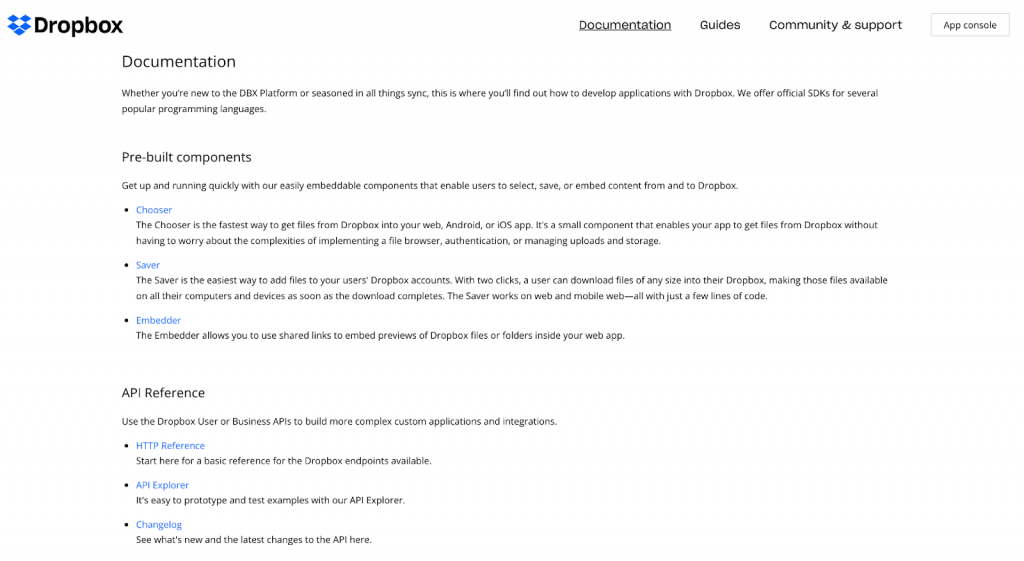
© WhatFix
Request for Proposal (RFP)
RFP is a document used by an organization to solicit proposals from potential suppliers regarding a specific project. Generally, an RFP details the project objectives and requirements, along with evaluation criteria, deadlines, and other relevant information. Interested vendors respond to the RFP with detailed proposals outlining how to approach and meet the established requirements.
The RFP is a common tool in the procurement process. It allows organizations to evaluate and compare proposals from different suppliers before making a final decision.
Below, you can check a form field created by Jay Dev to help users understand how to make a Request for Proposal and customize it in your own way.
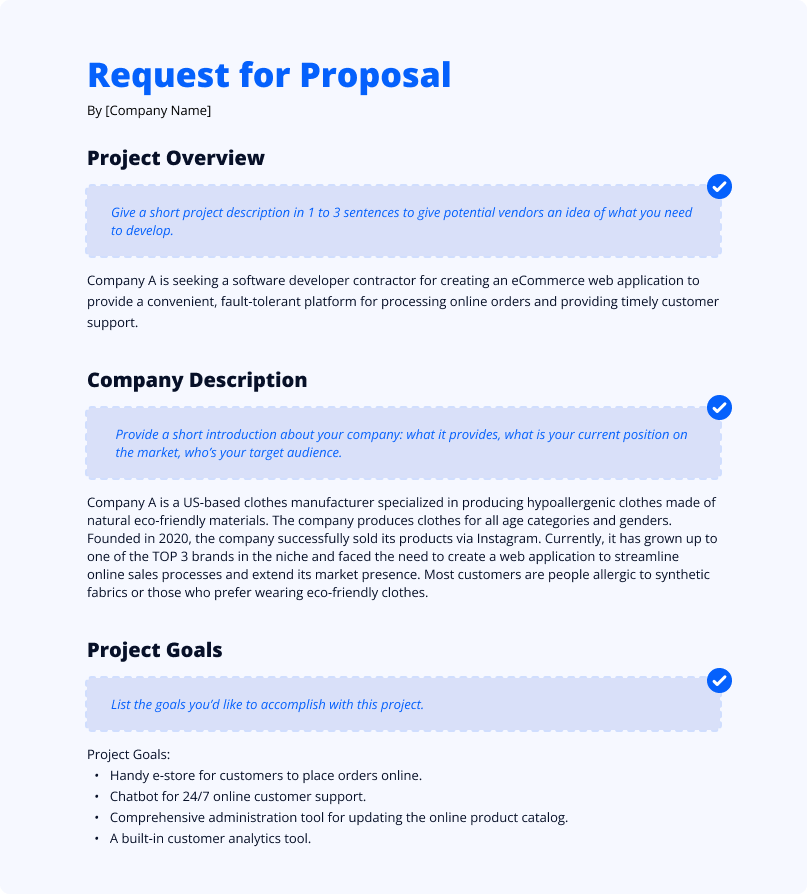
© JayDevs
User Manuals
User Manuals, or user guides, are vital documents that provide distinct instructions on using products or services. They are academic courses aimed at first-time users, assisting them in using a wide range of merchandise, from electronics and appliances to tools and SaaS solutions for businesses. These manuals are user-friendly and adequately illustrated, highlighting common problems and key functions.
Additionally, technical writers work must collaborate with engineers, programmers, and product designers to cover all necessary records. Below, you can see an example of a user manual. It is an Equipment Management Plate Installation made by the UNI-EMP. Their collaboration shows clear instructions on how to install a plate of Gearbox.
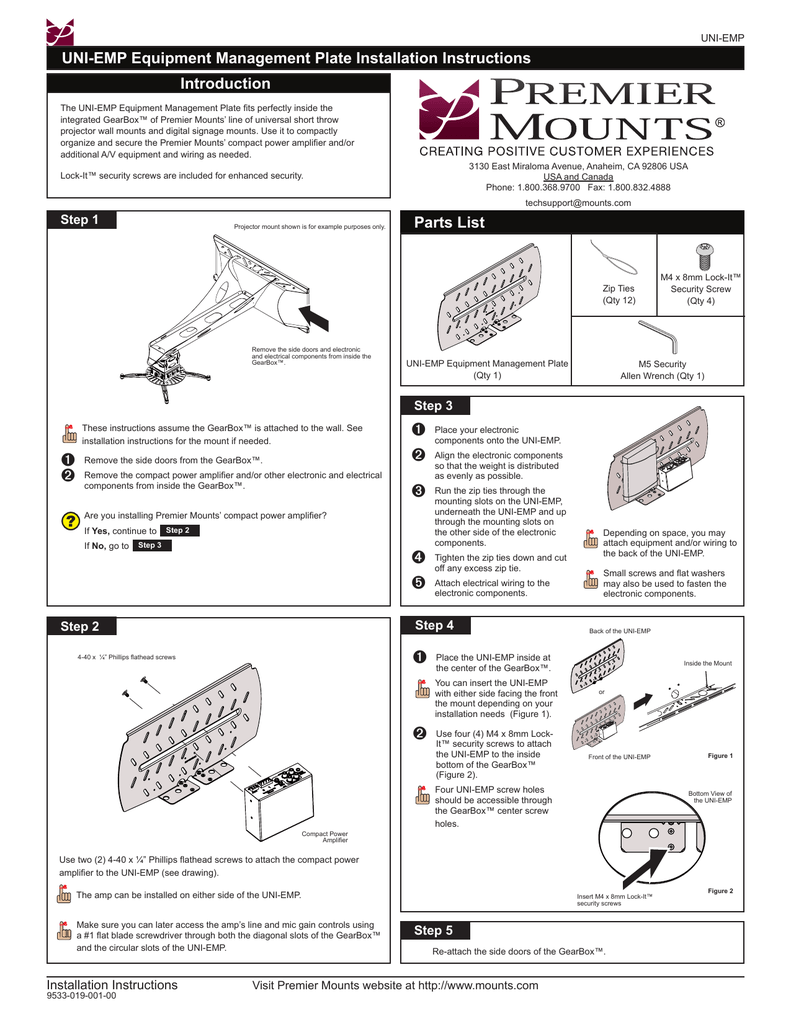
© Manualzz
Installation Guides
An installation guide is a document that gives particular commands on setting up a product or software. It is designed to help users carry out setup successfully and efficiently, ensuring that the product functions as expected.
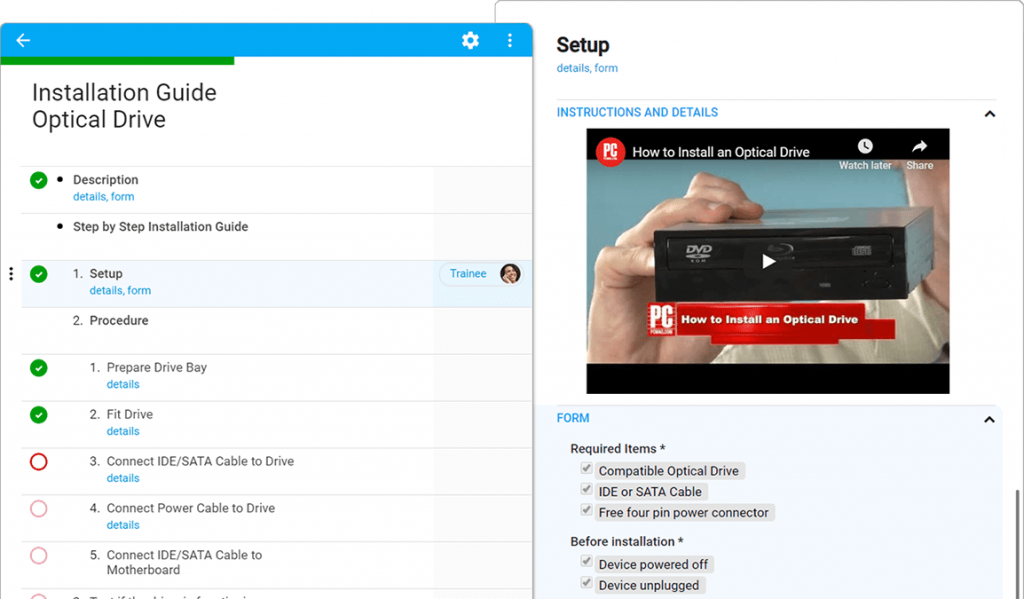
© WhatFix
The image shows an installation guide for an optical drive. This guide offers clear instructions accompanied by detailed videos and step-by-step instructions on the physical installation of the drive. A familiar layout and security notes ensure an intuitive and safe experience for the reader.
Whitepapers
Whitepapers are informative, technical, and often detailed documents that comprehensively analyze a specific topic, technology, product, or complex issue. White Papers are frequently used in companies, academic, and government contexts to communicate important information, research, solutions, or recommendations clearly and authoritatively.
You can check Julep Media’s Whitepaper for the examples below. They use clear information, and the report kicks off with a dynamic bird’ s-eye gif of their work with Generation Leads. It gives you an instant impression of the white paper’s goal.
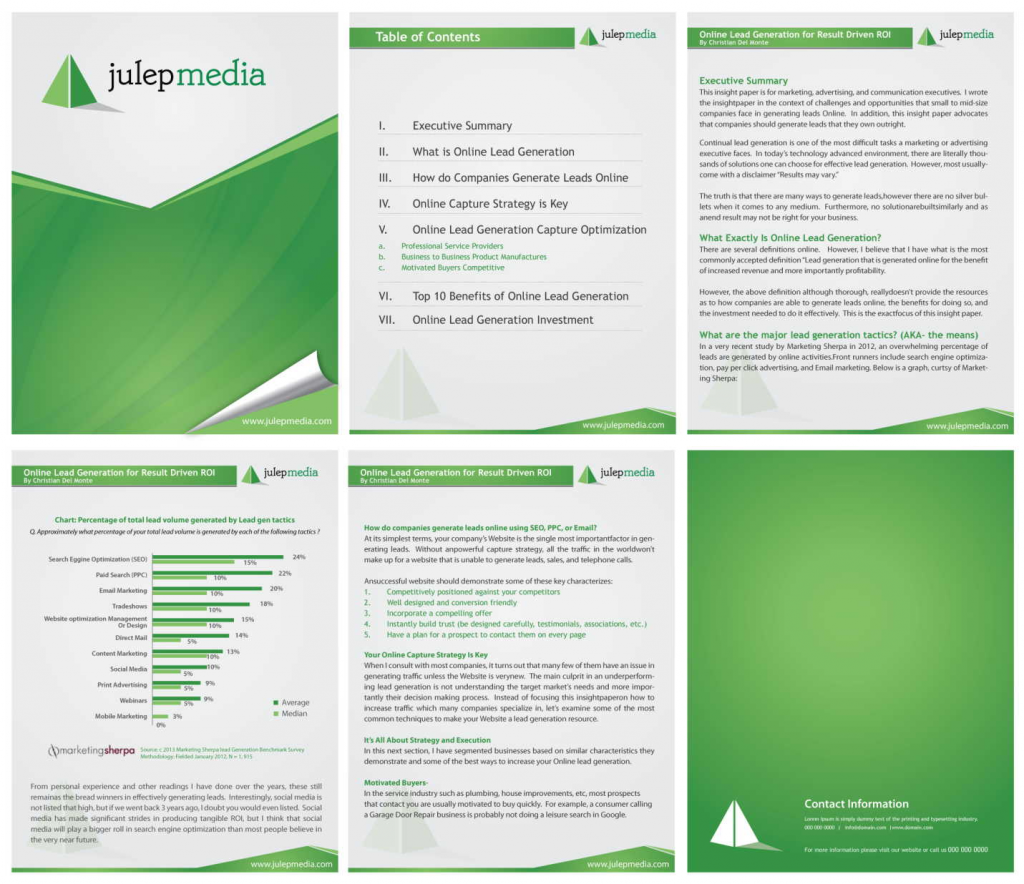
© Weblium
Standard Operating Procedures (SOP)
A Standard Operating Procedure (SOP) is a meticulously crafted set of written instructions that describe the step-by-step process for carrying out routine activities. These procedures follow a consistent approach, ensuring organizational compliance with industry regulations and business standards.
SOPs not only establish the policies, standards, and processes crucial to organizational success, but they also serve to minimize errors, increase profitability, and improve operational efficiency. Additionally, they promote a conducive work environment and provide guidelines for resolving problems and overcoming obstacles.
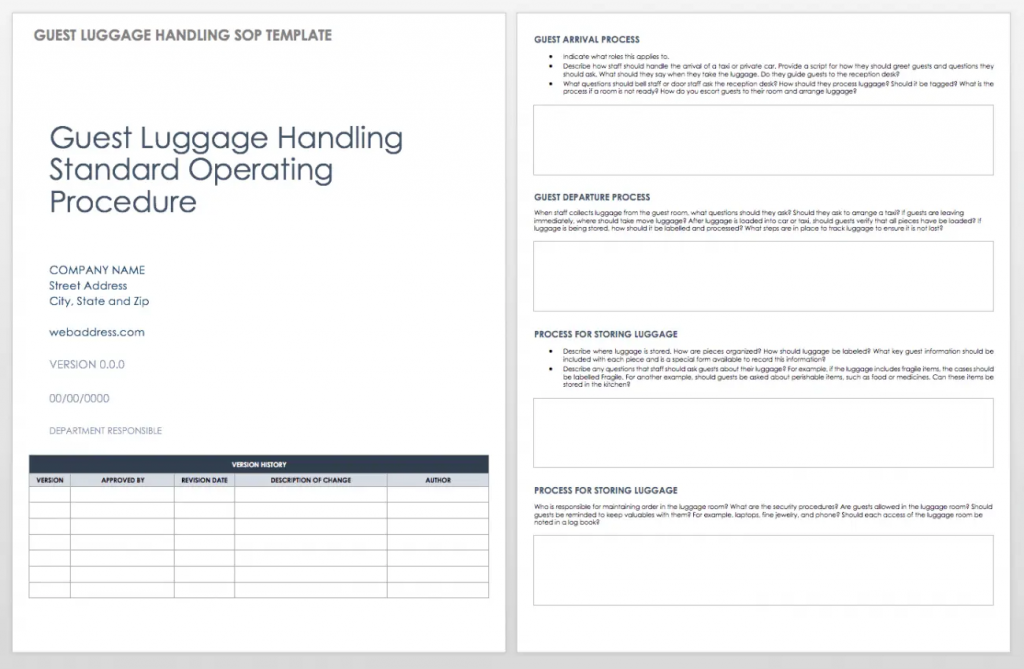
Above, you can see form fields created by Smartsheet to help users understand how to create and customize a Standard Operating Procedure to suit their needs.
What Is UX Writing
UX Writing (User Experience Writing) is a discipline that focuses more on the user interface and interaction with digital products or services.
UX writing is crucial in digital product development, as it creates brief and to-the-point texts that lead a user through an interface, thus ensuring that the experience is smooth and intuitive.
In short, the UX Writing text follows a consistent brand voice, maintaining cohesion and brand recognition throughout the app. This helps build trust and familiarity with the product. Additionally, system and login errors can disrupt the user journey, so providing clear, helpful messages to guide users in these situations is crucial, reducing frustration and improving retention.
Promising UX writing goes beyond correct grammar and spelling. It seeks to understand users’ needs and expectations, communicating with them authentically and engagingly. By providing a consistent brand voice, clear guidance, and helpful messaging, UX writers help create experiences that are intuitive, engaging, and genuinely user-centric.
UX Writers
User experience writing is a specialized writing practice performed by user experience writers. A UX writer works closely with user experience designers and other stakeholders to create text that improves users’ interactions with digital interfaces. These writers are responsible for communicating information clearly and concisely, especially regarding complex ideas or technical information, ensuring the target audience easily understands the instructions and guidance provided.
UX writers need exceptional communication skills, technical knowledge, and an understanding of the target audience’s needs and expectations. They may be involved in various tasks, from creating instruction manuals and technical documents to writing knowledge-based articles and job descriptions. Additionally, they can participate in user testing to ensure that the texts created meet the needs and preferences of end users. In short, UX writers play a crucial role on the UX team, contributing to creating intuitive and compelling digital interfaces.
Examples of UX Writing
Next, we will look at some UX writing examples.
Microcopy On Buttons And Links
Microcopy refers to short, to-the-point texts on buttons and hyperlinks that guide users to the motion they may take when they click. These texts are important to make sure users understand exactly what’s going to occur when they interact with a button or hyperlink. For example, “Add to Cart”, “Login,” “Continue,” and so forth. This microcopy wishes to be concise and precise, sincerely conveying the movement in a good way to be executed.
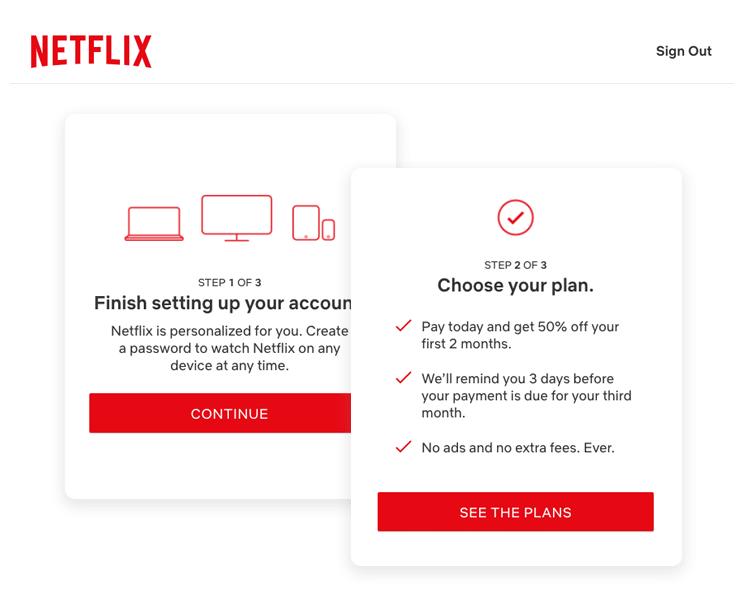
© Loop 11
In this example, Netflix stands out with its microcopies, making the main goal (plan registration) an easy and cohesive process, providing a pleasant experience to future customers.
Error Message
Error messages are texts that honestly explain the mistake that occurred and offer advice on how to fix it. They are vital in assisting customers in understanding what went wrong and how they can remedy the difficulty – for instance, “Incorrect password. Please try once more.” These messages must be clear and specific, and provide useful guidance for customers to clear up their troubles quickly.
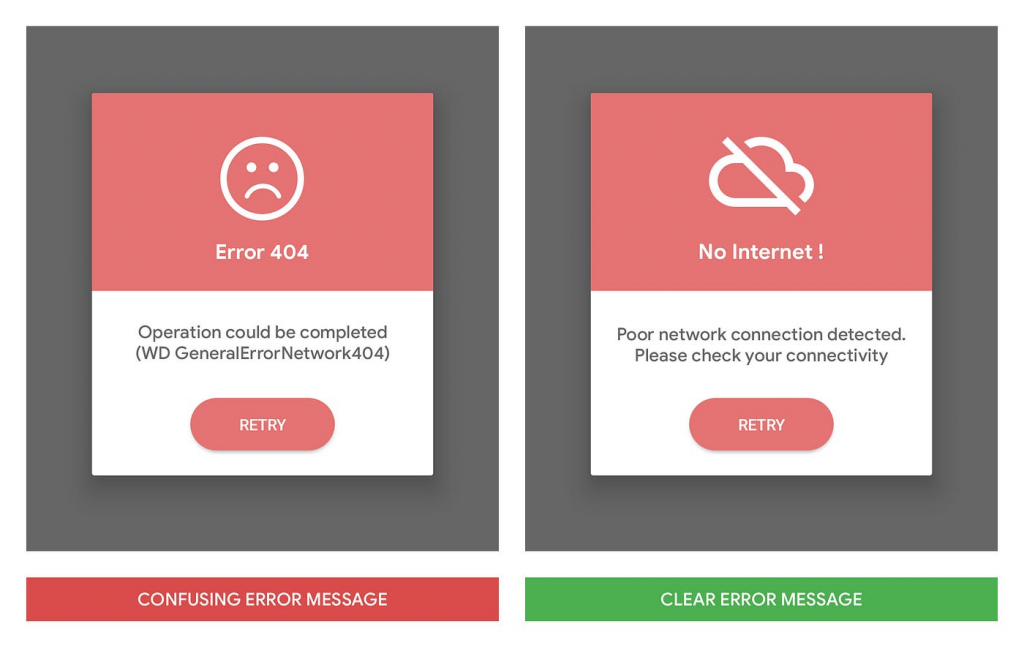
© Medium
The example above shows a general connection failure message. This can often irritate the user, but in this UX writing, the steps to resolve the issue are presented immediately: “Please check your connectivity,” followed by a button to refresh the page. This minimizes user frustration time, offering a quick and efficient solution.
Error Pages
Error pages contain instructions and guidance that assist users while using the product by providing clear, concise instructions. For example, “Drag to update,” “Drag and drop items here,” etc.
Additionally, they provide system feedback, such as messages that inform users about the status of an action in progress. For example, “Loading…”, “Operation completed successfully”, etc.
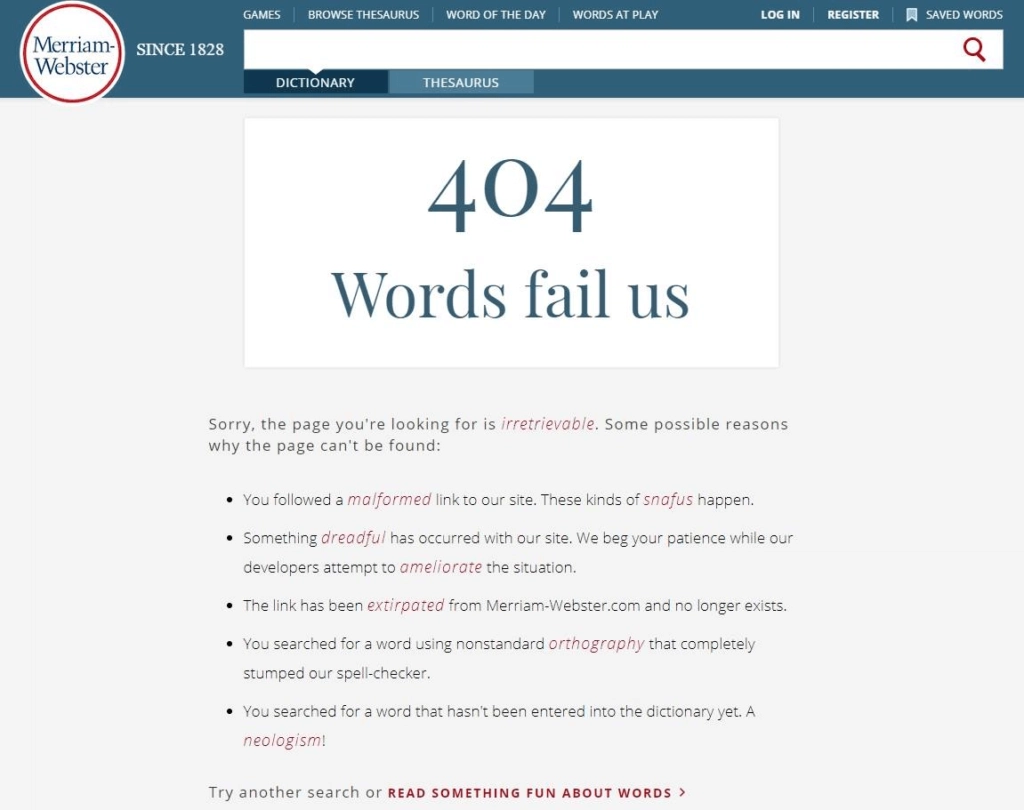
© UX writing hub
An excellent example is Merriam-Webster’s error page, which explains the error, what to do next, and why it happened, guiding users through the steps with a relaxed tone. Defining words reinforces their identity and keeps users engaged, showing they care about the user experience even during frustrating moments.
System Feedback
System feedback is a form of communication that informs users about the popularity of an ongoing action or manner within a gadget or utility. These messages are critical for keeping users informed about what’s taking place behind the curtain as they interact with the personal interface.
For instance, when a consumer performs a movement that requires some processing time, such as filing a form or appearing in a search, an appropriate message may be displayed to suggest that the machine is processing the request.
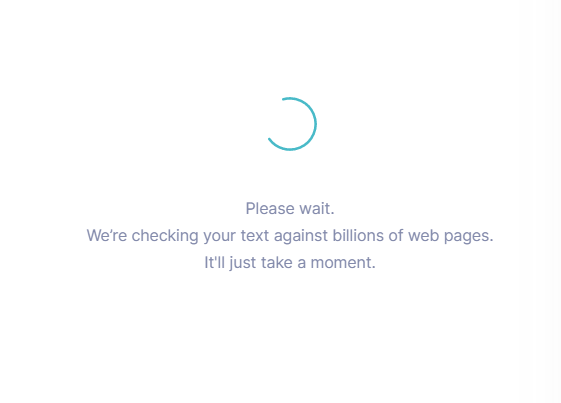
© Medium
As confirmed in the general example above, the message “please wait” prevents customers from becoming frustrated or upset due to the device’s unresponsiveness, offering a smoother, more transparent experience. This UX Writing content is from an anti-plagiarism platform. It shows that the site is “working” on its behalf, looking for plagiarism in the text and explaining what is happening to the customer.
Confirmation Messages
Confirmation messages validate customers’ actions, assisting in lessening tension and uncertainty. They affirm that the motion was finished efficiently, which is important for establishing agreement and credibility on the platform.
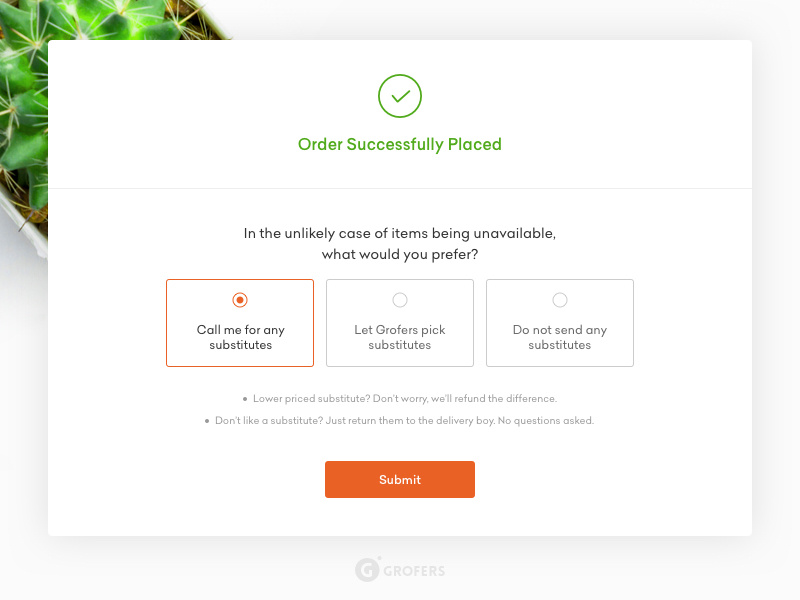
© Dribbble
In this example, in addition to offering an easy confirmation, the confirmation message also consists of additional info applicable to the person’s experience, including subsequent steps to take, facts about what to anticipate next, or even a preview of the changes made. This way, the confirmation message no longer only validates the consumer’s movement but offers extra guidance when needed.
CTAs (Call-to-Actions)
CTAs, or Calls to Action, are texts that inspire users to take a specific action, such as purchasing a product, signing up for an e-newsletter, or participating in a survey. Examples include buttons like “Buy now,” “Sign up at no cost,” and “Take part in the survey.”
These texts need to be persuasive and direct, encouraging users to act in accordance with the desired objective. The purpose of CTAs is to direct users’ attention to a specific action and motivate them to perform it, thus contributing to the success of the company’s business or marketing goals.

This example shows clear, persuasive copywriting accompanied by GitHub’s “Sign up for free” CTA. Due to its clarity and direct appeal, everything is highly effective. The CTA’s defined tone and strategic placement demonstrate high-level copywriting skills that invite clients to decide and take the first step toward better software development.
Summing It Up
Tech writing and UX writing are two essential disciplines that work closely together and play a significant role in developing merchandise and improving consumer experience.
While each area shares the aim of helping users carry out obligations and obtain them successfully, they approach those desires otherwise. Technical writing is more oriented towards targeted and accurate information, while UX writing specializes in creating a pleasant and engaging personal experience. However, each plays a crucial function in a software product’s achievement, complementing each other to provide an outstanding consumer experience.
So, whether you’re a senior technical author, a UX designer specialist, or an early-profession professional, knowing the differences between technical writing and UX writing is essential to play a sizeable role in growing successful merchandise.
With this in mind, it’s essential to understand every area’s unique contribution to the software development system and how they work together to create a pleasing and practical user experience. By maintaining readability, consistency, and relevance in your writing, you can drastically contribute to fulfilling software projects and consumer enjoyment.

With a degree in Public Relations and an MBA in Marketing from the best university in Brazil, she brings with her over six years of solid experience as a digital marketing strategy specialist, social media specialist and copywriter. Privately, he is a lover of traveling and the world of cinema.

